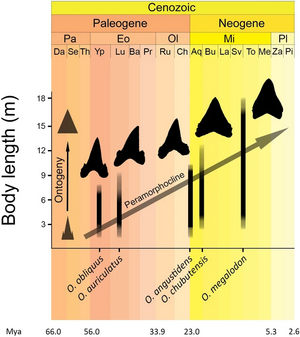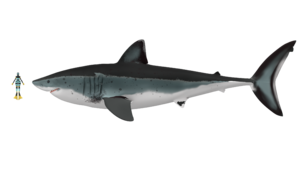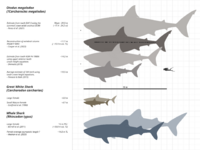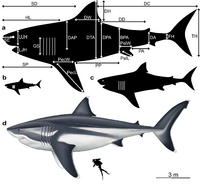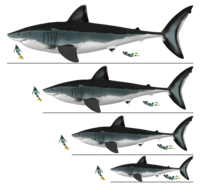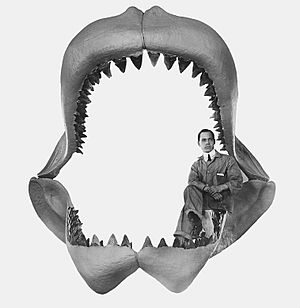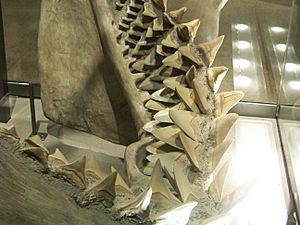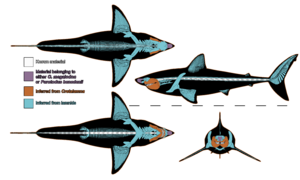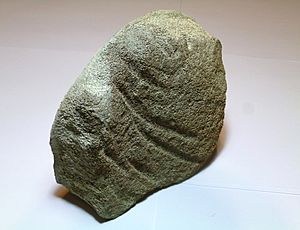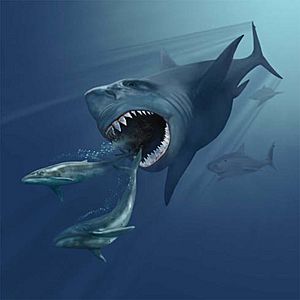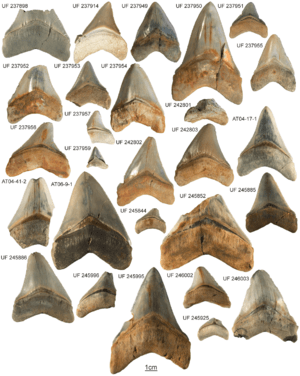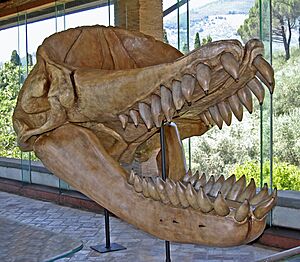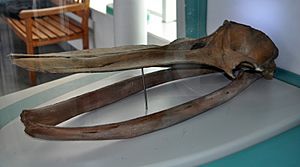Megalodon facts for kids
Quick facts for kids Megalodon |
|
|---|---|
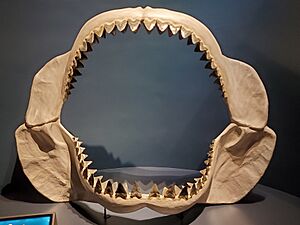 |
|
| Model of Megalodon jaws at the Tellus Science Museum | |
| Scientific classification | |
| Genus: |
Otodus
|
| Species: |
megalodon
|
| Synonyms | |
|
List of synonyms
Genus Carcharias
Genus Carcharocles
Genus Carcharodon
Genus Megaselachus
Genus Procarcharodon
Genus Otodus
Genus Selache
|
|
The Megalodon (pronounced MEG-uh-luh-don), whose name means "big tooth," was a giant, extinct shark. It lived about 23 to 3.6 million years ago, during the Early Miocene to the Early Pliocene periods. This amazing prehistoric fish was once thought to be a close relative of the modern great white shark. However, scientists now believe it belonged to a different extinct family called Otodontidae. This family split off from the great white shark's ancestors much earlier.
Megalodon is considered one of the largest and most powerful predators that ever lived. We mostly know about it from its fossilized teeth and vertebrae. Because of this, its exact appearance and maximum size are still a bit of a mystery. Scientists have different ideas about whether it looked more like a stocky great white shark or had a longer, more streamlined body. Estimates for its total length range from about 14.2 to 24.3 meters (46 to 80 feet). However, most adult Megalodons were likely around 10.5 meters (34 feet) long. Their teeth were very thick and strong, perfect for grabbing prey and crushing bones. Its huge jaws could deliver a bite force of up to 182,200 Newtons, which is incredibly powerful!
Megalodon likely had a huge impact on the ocean's animal communities. Its fossils have been found all over the world, showing it lived in many different places. It probably hunted large animals like whales, seals, and sea turtles. Young Megalodons lived in warm coastal waters, eating fish and smaller whales. Unlike great white sharks, which often attack from below, Megalodon might have used its powerful jaws to crush the chest cavity of its prey, damaging vital organs.
This giant shark faced competition from other large ocean predators, such as ancient whale-eating sperm whales like Livyatan. Scientists believe that the cooling of the oceans, which led to the ice ages, played a big role in its disappearance. Lower sea levels also destroyed important nursery areas where young sharks grew up. A decrease in the number and variety of baleen whales, which were a main food source, also contributed to Megalodon's extinction. Interestingly, the extinction of Megalodon happened around the same time that baleen whales started to grow much larger.
Contents
Discovering the Megalodon
Ancient Teeth and Early Ideas
For thousands of years, people found giant, triangular teeth and wondered what they were. Ancient cultures in the Americas, like the Algonquin peoples, used these teeth for tools, jewelry, and ceremonies. They even traded them!
Around 73 AD, a Roman writer named Pliny the Elder wrote about these "tongue stones" (glossopetrae). People believed they were petrified human tongues that fell from the sky during lunar eclipses. Later, in Malta, people thought they were the stone tongues of serpents turned to rock by Paul the Apostle. They even believed these stones could cure poison! Rich people in the Middle Ages and Renaissance wore them as amulets or used them in tableware, hoping they would protect against poisons.
Scientists Uncover the Truth
It wasn't until the 17th century that scientists figured out these "tongue stones" were actually shark teeth. In 1616, an Italian naturalist named Fabio Colonna published drawings comparing a Maltese "tongue stone" to a modern great white shark tooth. He noticed how similar they were and argued that these were indeed fossilized shark teeth. He even burned samples and saw carbon residue, which suggested they came from living things.
Later, in 1667, a Danish scientist named Niels Steensen (also known as Nicholas Steno) further supported this idea. He studied the head of a great white shark and showed how similar its teeth were to the fossilized ones. He also explained that these teeth could be found far from the sea because the land itself had changed over millions of years, rising from ancient seabeds.
Naming the Giant Shark
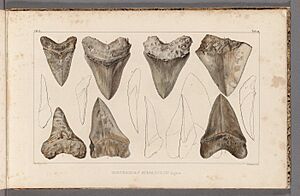
The famous Swiss naturalist Louis Agassiz gave the Megalodon its scientific name in the 1830s. He first called it Carcharias megalodon in 1835. The name "megalodon" comes from ancient Greek words: megálos meaning "big" and odṓn meaning "tooth." So, it literally means "big tooth"! Agassiz later changed the name to Carcharodon megalodon because its teeth were much larger than those of the Carcharias genus and more like the great white shark's.
How Megalodon Evolved
Scientists believe Megalodon lived from about 28 million years ago to 3.6 million years ago. For a long time, people thought Megalodon was a direct ancestor of the great white shark. This was because their teeth looked similar. However, most scientists now think this similarity is due to something called convergent evolution. This means two different species can develop similar features because they live in similar environments or hunt in similar ways, not because they are closely related.
Today, Megalodon is classified in the genus Otodus, making its full scientific name Otodus megalodon. The great white shark is actually more closely related to the extinct broad-toothed mako shark. The teeth of Megalodon have much finer serrations (like tiny saw edges) than great white shark teeth. The great white shark's family tree connects more closely to mako sharks.
The Otodus lineage, which includes Megalodon, shows a gradual change in tooth shape over millions of years. Their teeth became more serrated, wider, and more triangular. They also lost the small side points (lateral cusps) on their teeth. These changes suggest a shift in how they hunted, from tearing and grasping fish to cutting through the flesh of larger prey like whales.
| Lamniformes |
|
|||||||||||||||||||||||||||||||||||||||||||||
Megalodon's Biology
What Megalodon Looked Like
Scientists have different ideas about Megalodon's exact appearance. Some think it looked like a super-sized, very strong version of the great white shark. Its jaws might have been wider and blunter, and its fins thicker. It might have had small, deep-set eyes.
Other scientists suggest Megalodon looked more like a whale shark or a basking shark. These sharks have a crescent-shaped tail fin and small dorsal and anal fins. This body shape helps large aquatic animals move through water with less resistance.
In 2024, new research suggested Megalodon might have had a longer, more stretched-out body than previously thought. This could mean it was even longer than earlier estimates!
How Big Was Megalodon?
It's hard to know Megalodon's exact size because we only have fossilized teeth and vertebrae (backbones). Scientists use the great white shark as a model to estimate Megalodon's size, as it's the closest living comparison.
Estimates for Megalodon's maximum length vary, from about 14.2 to 24.3 meters (46 to 80 feet). For comparison, a large great white shark is usually around 6 meters (20 feet) long. The largest living fish, the whale shark, can reach about 18.8 meters (62 feet). Most Megalodons, from young to adult, were probably around 10.5 meters (34 feet) long.
In 2020, scientists created a 2D model of a 16-meter (52-foot) Megalodon. They estimated it would have a 4.65-meter (15-foot) head and a 3.85-meter (12.6-foot) tall tail fin! A 2022 3D model suggested a 16-meter Megalodon could weigh about 61.56 tons. This huge size might have been due to warm climates and lots of large prey. Megalodon was likely the biggest predatory shark that ever lived.
Scientists also think Megalodon was a "regional endotherm" (mesotherm). This means it could keep its body warmer than the surrounding water, like some modern sharks. This would have helped it swim faster and hunt more effectively.
How Scientists Estimate Size
One of the first attempts to guess Megalodon's size was in 1909. A jaw reconstruction suggested it could be up to 30 meters (98 feet) long! However, this was an overestimate because the cartilage in the jaw was made too large.
Today, scientists use different methods based on tooth size. For example, some methods use the height of the tooth's enamel or the width of its root. In 1996, researchers estimated a maximum length of 15.9 meters (52 feet) based on a 16.8 cm (6.6 inch) tall tooth. Other methods have led to estimates of up to 20 meters (66 feet) or even 24.3 meters (80 feet) for the largest individuals.
There are stories of even bigger teeth found by fossil hunters, but these are not always scientifically confirmed.
Megalodon's Teeth and Bite Force
Megalodon's teeth are the most common fossils we find. They are triangular, very strong, large, and have fine serrations (like tiny saw blades). They don't have small side points like some other shark teeth.
These teeth were anchored firmly in the jaw. The front teeth were straight and symmetrical, while the back teeth were slanted and asymmetrical. Megalodon teeth can be over 180 mm (7 inches) long diagonally, making them the largest of any known shark! This shows how big and powerful this shark was.
A nearly complete set of Megalodon teeth was found in Japan in 1989. Another set from the United States helped scientists create a model of its jaw. Megalodon had over 250 teeth arranged in 5 rows! Its jaws could open very wide, possibly up to a 75-degree angle.
In 2008, scientists studied the bite force of a great white shark and then scaled it up for Megalodon. They estimated Megalodon's bite force could be between 108,514 to 182,201 Newtons. This is about 10 times stronger than the largest great white shark's bite! When sharks shake their heads while feeding, this force would have been even greater.
Inside Megalodon's Body
Like all sharks, Megalodon's skeleton was made of cartilage, not bone. Cartilage doesn't fossilize as well as bone, which is why we mostly find teeth. However, some fossilized vertebrae (backbones) have been found. One partial backbone from Belgium had 150 vertebrae, with the largest being 155 mm (6 inches) across. This suggests Megalodon had more vertebrae than any known shark, possibly over 200!
Scientists have also found fossilized poop (called coprolites) from Megalodon. These are spiral-shaped, showing that Megalodon had a spiral valve in its intestines, just like modern sharks.
Using all these clues, scientists have created full skeleton reconstructions of Megalodon. One such model, 11.3 meters (37 feet) long, is on display at the Calvert Marine Museum in the United States.
Megalodon's Life and Environment
What Megalodon Ate
Megalodon was an apex predator, meaning it was at the very top of the food chain. Its huge size, fast swimming, and powerful jaws allowed it to eat a wide variety of animals. Studies of its teeth show it ate marine mammals, marine reptiles, bony fish, and other sharks.
Fossil evidence clearly shows that Megalodon hunted many types of cetaceans (whales and dolphins). This included small whales, sperm whales, and even large rorquals. It also preyed on seals, sirenians (like manatees), and sea turtles. Many whale bones have been found with deep gashes from Megalodon teeth.
Young Megalodons likely ate more fish and small whales. As they grew, they moved to deeper waters and hunted larger whales.
How Megalodon Hunted
Sharks often use clever strategies to hunt large prey. Megalodon's hunting methods might have been similar to those of the great white shark, but with some key differences due to its massive size.
Unlike great white sharks, which often attack the soft underside of their prey, Megalodon likely aimed for the heart and lungs. Its thick teeth were perfect for biting through tough bones, as seen in bite marks on the rib cages of fossilized whales.
For smaller whales, Megalodon might have rammed them with great force from below before delivering a fatal bite. There's also evidence that it might have attacked the heads of raptorial sperm whales, aiming to break their jaws.
As larger whales appeared during the Pliocene, Megalodon seemed to adapt its strategies. Bite marks on the flipper and tail bones of large whales suggest that Megalodon would first immobilize its prey before killing and eating it.
Growth and Reproduction
Scientists believe Megalodon grew very quickly, almost twice as fast as a great white shark. It likely reached sexual maturity around 25 years of age. One study of a Megalodon backbone suggested an individual lived to be 46 years old, growing about 16 cm (6 inches) per year, and was about 2 meters (6.5 feet) long at birth. For the largest Megalodons, their lifespan could have been 88 to 100 years.
Megalodon, like modern sharks, used special nursery areas to give birth and raise its young. These were warm, coastal waters with plenty of food and protection from other predators. Nursery sites have been found in places like Panama, Maryland, and Florida. Baby Megalodons were quite large, around 3.5 meters (11.5 feet) long at birth! They were still vulnerable to other sharks, like the great hammerhead shark.
Where Megalodon Lived
Megalodon lived all over the world! Fossils have been found in Europe, Africa, the Americas, and Australia. It preferred warm, subtropical to temperate waters. It could live in temperatures from about 1°C to 24°C (34°F to 75°F). Its ability to keep its body warmer than the surrounding water (mesothermy) likely helped it survive in these varied temperatures.
Megalodon lived in many different ocean environments, including shallow coastal waters, lagoons, and deep offshore areas. Adult Megalodons mostly stayed in offshore areas, while younger ones might have spent more time closer to the coast.
Interestingly, fossils suggest that Megalodons in the Southern Hemisphere were generally larger than those in the Northern Hemisphere. They were also larger in the Pacific Ocean compared to the Atlantic.
Locations of Fossils
Megalodon fossils have been found globally, bordering all oceans during the Neogene period.
| Epoch | Formation | State | Continent |
|---|---|---|---|
| Pliocene | Luanda Formation | Africa | |
| Africa | |||
| Africa | |||
| Castell'Arquato Formation | Europe | ||
| Arenas de Huelva Formation | Europe | ||
| Esbarrondadoiro Formation | Europe | ||
| Touril Complex Formation | Europe | ||
| Red Crag Formation | Europe | ||
| San Mateo Formation | North America | ||
| Towsley Formation | North America | ||
| Bone Valley Formation | North America | ||
| Tamiami Formation | North America | ||
| Yorktown Formation | North America | ||
| Highlands Formation | North America | ||
| Refugio Formation | North America | ||
| San Diego Formation | North America | ||
| Tirabuzon Formation | North America | ||
| Onzole Formation | South America | ||
| Paraguaná Formation | South America | ||
| Black Rock Sandstone | Oceania | ||
| Cameron Inlet Formation | Oceania | ||
| Grange Burn Formation | Oceania | ||
| Loxton Sand Formation | Oceania | ||
| Whaler's Bluff Formation | Oceania | ||
| Tangahoe Formation | Oceania | ||
| Miocene | |||
| Africa | |||
| Madagascar Basin | Africa | ||
| Africa | |||
| Varswater Formation | Africa | ||
| Baripada Limestone | Asia | ||
| Arakida Formation | Asia | ||
| Bihoku Group | Asia | ||
| Fujina Formation | Asia | ||
| Hannoura Formation | Asia | ||
| Hongo Formation | Asia | ||
| Horimatsu Formation | Asia | ||
| Ichishi Formation | Asia | ||
| Kurahara Formation | Asia | ||
| Maenami Formation | Asia | ||
| Matsuyama Group | Asia | ||
| Sekinobana Formation | Asia | ||
| Suso Formation | Asia | ||
| Takakubo Formation | Asia | ||
| Tonokita Formation | Asia | ||
| Tsurushi Formation | Asia | ||
| Wajimazaki Formation | Asia | ||
| Yoshii Formation | Asia | ||
| Asia | |||
| Duho Formation | Asia | ||
| Asia | |||
| Burgeschleinitz Formation | Europe | ||
| Melker Sand Formation | Europe | ||
| Rzehakia Formation | Europe | ||
| Weissenegg Formation | Europe | ||
| Antwerpen Sands Member | Europe | ||
| Europe | |||
| Hrušky Formation | Europe | ||
| Gram Formation | Europe | ||
| Aquitaine Basin | Europe | ||
| Europe | |||
| Libano Sandstone | Europe | ||
| Blue Clay Formation | Europe | ||
| Globigerina Limestone | Europe | ||
| Aalten Member | Europe | ||
| Breda Formation | Europe | ||
| Korytnica Clays | Europe | ||
| Leitha Limestone | Europe | ||
| Esbarrondadoiro Formation | Europe | ||
| Filakovo Formation | Europe | ||
| Arjona Formation | Europe | ||
| Calcarenites of Sant Elm | Europe | ||
| Europe | |||
| Europe | |||
| Monterey Formation | North America | ||
| Puente Formation | North America | ||
| Purisima Formation | North America | ||
| San Mateo Formation | North America | ||
| Santa Margarita Formation | North America | ||
| Temblor Formation | North America | ||
| Topanga Formation | North America | ||
| Bone Valley Formation | North America | ||
| Calvert Formation | North America | ||
| Kirkwood Formation | North America | ||
| North America | |||
| Cojímar Formation | North America | ||
| Kendance Formation | North America | ||
| North America | |||
| Aymamón Limestone | North America | ||
| Almejas Formation | North America | ||
| Carrillo Puerto Formation | North America | ||
| Chagres Formation | North America | ||
| Chucunaque Formation | North America | ||
| Gatún Formation | North America | ||
| Paraná Formation | South America | ||
| Bahía Inglesa Formation | South America | ||
| Coquimbo Formation | South America | ||
| Castilletes Formation | South America | ||
| Miramar Formation | South America | ||
| Pisco Formation | South America | ||
| Camacho Formation | South America | ||
| Cantaure Formation | South America | ||
| Caujarao Formation | South America | ||
| Socorro Formation | South America | ||
| Urumaco Formation | South America | ||
| Batesford Limestone | Oceania | ||
| Black Rock Sandstone | Oceania | ||
| Gippsland Limestone | Oceania | ||
| Mannum Formation | Oceania | ||
| Morgan Limestone | Oceania | ||
| Port Campbell Limestone | Oceania | ||
| Oceania | |||
| Oceania | |||
| Unknown | Pacific Ocean |
Competition with Other Predators
Megalodon lived in a very competitive ocean. As the top predator, it likely had a big influence on other marine animals. The fossil record shows that as Megalodon appeared, many types of whales and other marine mammals also started to evolve and diversify.
Megalodon shared the oceans with other huge predators, like whale-eating toothed whales (especially large sperm whales). Some of these, like Livyatan, were also gigantic, reaching up to 17.5 meters (57 feet) long! These large whales were also apex predators, creating a lot of competition for food.
Megalodon might have also pushed out other shark species, like the great white shark, from warmer waters. In areas where their territories overlapped, they might have hunted at different times of the year or followed different prey. Megalodon probably also ate other Megalodons sometimes, just like modern sharks do.
Why Megalodon Disappeared
Climate Change and Ocean Cooling
The Earth's climate changed a lot during Megalodon's time. A cooling trend began about 35 million years ago, eventually leading to ice ages at the poles. Geological events, like the closing of the Central American Seaway, also changed ocean currents and weather patterns, making the oceans colder. This cooling might have reduced the amount of nutrient-rich water in some areas, negatively affecting Megalodon's food sources.
Huge drops in sea levels also occurred, which destroyed many of the shallow, warm coastal areas that Megalodon used as nurseries for its young. These nursery areas are super important for young sharks to grow safely. Without them, it would have been harder for Megalodon to reproduce successfully.
Since Megalodon preferred warmer waters, the shrinking warm areas might have limited where it could live. However, some studies suggest that Megalodon could handle a wider range of temperatures than previously thought, so temperature changes alone might not be the only reason for its extinction.
Changes in the Ocean Ecosystem
The Miocene period, when Megalodon thrived, was a time of great diversity for marine mammals, especially baleen whales. This abundance of prey was perfect for a super-predator like Megalodon. However, by the end of the Miocene, many whale species had gone extinct. The remaining whales might have become faster and harder to catch.
The extinction of Megalodon matches the decline of many smaller baleen whale groups. It's possible Megalodon relied heavily on these smaller whales for food. A large extinction event during the Pliocene also wiped out many large marine species, including whales, seabirds, and sea turtles. This event especially affected warm-blooded and mesothermic animals, suggesting a decrease in food supply. Megalodon might have simply been too big to survive on the dwindling food resources.
Competition from other large predators also played a role. Whale-eating toothed whales, like the giant Livyatan, were present during Megalodon's time. While these large sperm whales declined by the Late Miocene, other predators, like early forms of killer whales, appeared in the Pliocene. Although these early killer whales might not have been specialized whale hunters like modern ones, they still added to the competition for food.
Scientists believe that a combination of factors led to Megalodon's extinction: climate change, the loss of nursery areas, a decrease in its main food sources (especially smaller whales), and competition from other large marine predators. After Megalodon disappeared, baleen whales grew even larger, perhaps because they no longer had to fear the giant shark.
See also
 In Spanish: Megalodón para niños
In Spanish: Megalodón para niños
- List of prehistoric cartilaginous fish
- Largest prehistoric organisms


